The Apple iPhone 6s and iPhone 6s Plus Review
by Ryan Smith & Joshua Ho on November 2, 2015 8:00 AM EST- Posted in
- Smartphones
- Apple
- Mobile
- SoCs
- iPhone 6s
- iPhone 6s Plus
Display
In pretty much any smartphone, displays are going to be one of the most important aspects of the user experience. If a display is dim or has a highly reflective display it will be unreadable outdoors. If the contrast is low, the display can become difficult to read and not particularly appealing to the eye. Other issues like lack of color stability and contrast stability with changes in viewing angles will be much more noticeable than on something like a laptop or desktop where the monitor is usually kept at a constant position in space relative to the eye. In order to evaluate these factors we use both relative comparisons and absolute measurements. Although the human eye is sufficient for relative comparison, for absolute measurements we use X-Rite’s i1Pro2 spectrophotometer for precise color and luminance measurements, along with X-Rite’s i1Display Pro colorimeter for accurate contrast figures. Hardware alone is insufficient for collecting and presenting data, so we also use SpectraCal’s CalMAN 5 with a custom workflow, which allows for collecting and presenting data in a readable manner.
In the case of the iPhone 6s and iPhone 6s Plus, the display appears to be effectively unchanged from the iPhone 6 and iPhone 6 Plus. The iPhone 6s retains the 1334x750 resolution of the previous variant, and the iPhone 6s Plus has the same 1080p resolution as well. Apple continues to use the same M2 scaler as well, which means that although the display’s physical resolution is 1080p Apple is actually rendering the display at 2208x1242 and scaling it to fit the display. The resolution of the iPhone 6s is on the low side relative to most Android devices, which is noticeable but the pixel density is sufficient to avoid any obvious problems here.
As with the iPhone 6, both the iPhone 6s and 6s Plus use dual domain pixels, which make the subpixels look more like chevrons under a microscope. This improves viewing angles by reducing the amount of color shifting that occurs when the display viewing angle is changed. As far as I can tell, Apple continues to be one of the few OEMs that pulls this off effectively. Although contrast and luminance aren’t perfectly consistent with changes in viewing angles, it basically looks like the display is painted underneath the glass. The iPhone 6s Plus does a better job at pulling off this illusion as the higher pixel density helps to eliminate some of the fuzziness or pixilation that might otherwise occur. Samsung gets close here, but for whatever reason ambient light causes noticeable interference effects and in general there’s noticeable color shift when moving the display around. Weirdly enough, the OEM that seems to be doing the best job here continues to be HTC with the One M9+.

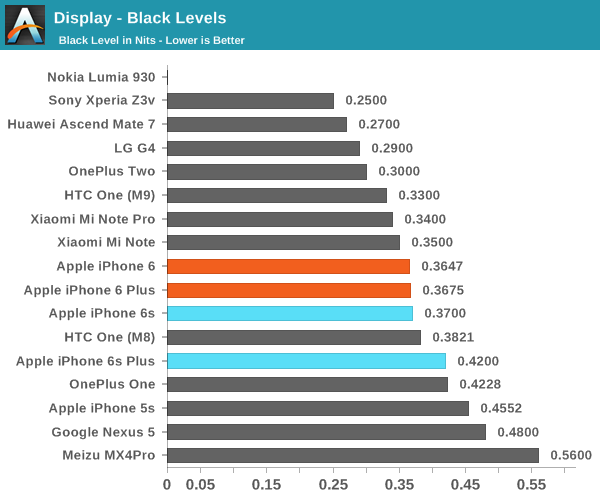
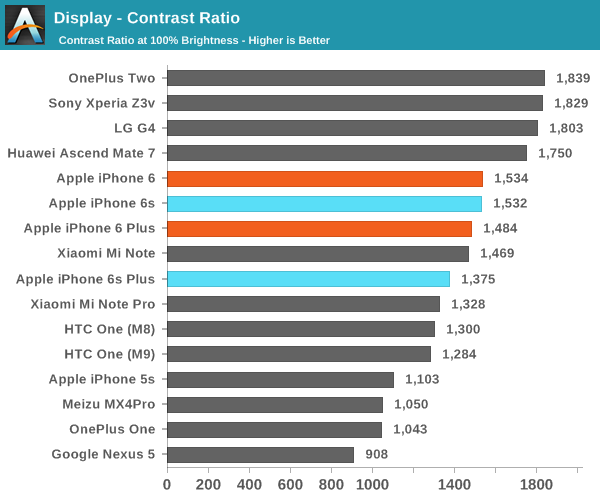
Moving on to our usual brightness and contrast testing, it looks like Apple has improved the maximum brightness of their displays with the use of the new LED backlight driver, but it’s important to note that in the case of the iPhone 6s, the maximum brightness isn’t constant. The behavior is relatively subtle, but with iOS 9 at maximum brightness the display brightness steadily lowers over the course of an hour by about 10 nits maximum. It looks like this effect tails off in both the rate of luminance decrease and overall luminance decrease as peak brightness approaches 500 nits, where the effect appears to be non-existent. It’s likely that this behavior is designed to reduce the battery impact of keeping the display at maximum brightness in all situations. Either way, peak luminance is high enough that it isn’t a struggle to read the display outdoors and contrast in low-light conditions also remains high due to the use of photo-alignment in the liquid crystal layer which helps to make the liquid crystals stay in the right shape.
iPhone 6s
iPhone 6s Plus

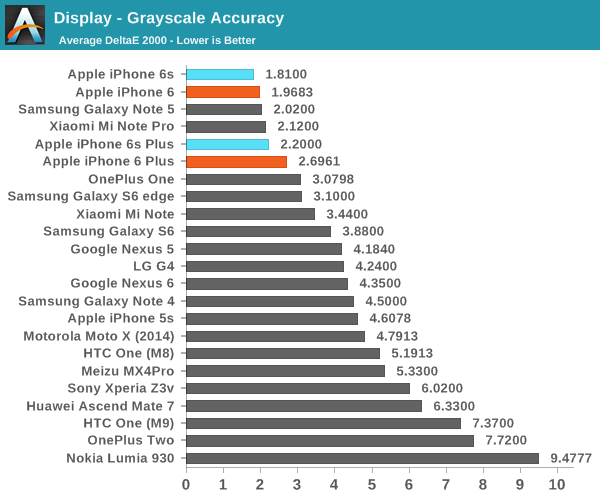
In grayscale, we don’t quite see the near-perfect white balance we saw last year but gamma remains almost impeccable when compared to the industry standard power 2.2 gamma. I suspect that the units we received this time are closer to the mean for white balance compared to last year, as in general due to the blue LED backlights used in most LCDs a colder color balance will generally require less power to display than a warmer one.
iPhone 6s
iPhone 6s Plus

In our saturation sweep testing, the iPhone 6s and 6s Plus both continue to track closely to expected values for sRGB, which is the current industry standard color gamut. I don’t really have any criticism here. The previous iPhone’s displays were of similar caliber, so this is pretty much par for the course if you’re used to iPhone displays.
iPhone 6s
iPhone 6s Plus
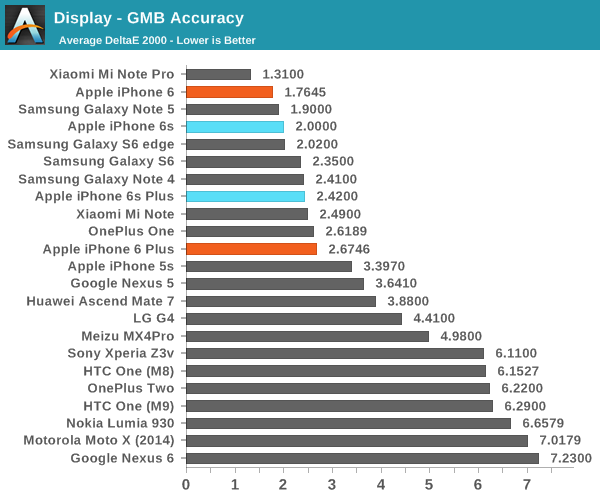
Similarly in the GMB ColorChecker, the iPhone 6s and 6s Plus both pass with flying colors. If you’re using an iPhone 6s or 6s Plus for any remotely color-critical work like viewing and/or editing photos and videos, it’s a pretty fair bet that you’ll be able to rely on these phones to provide an accurate color reproduction in pretty much any condition. Samsung does provide better contrast and the possibility of extra color saturation with their Galaxy S6 and Note 5, but this comes at the cost of potential for burn-in, increased power consumption in certain scenarios, and increased distortion with changes in viewing angles. I think this means that it basically comes out to a wash, but depending upon personal taste one may prove to be better than another.



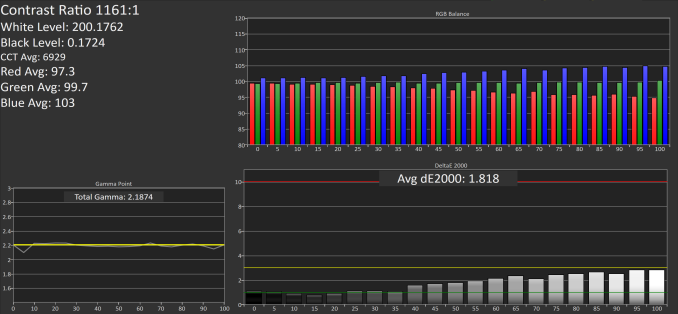
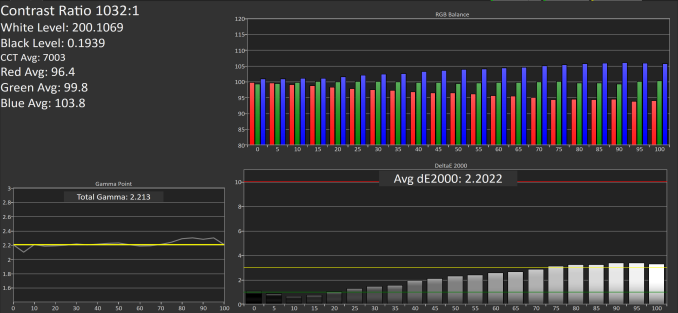
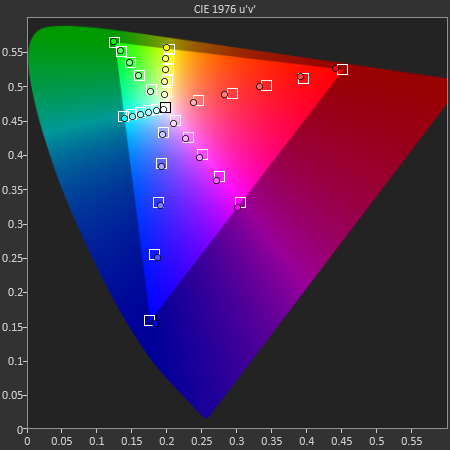
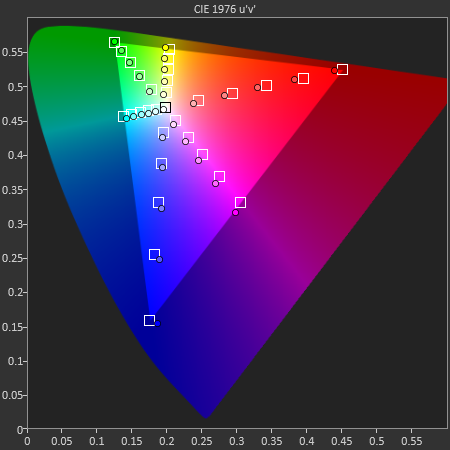
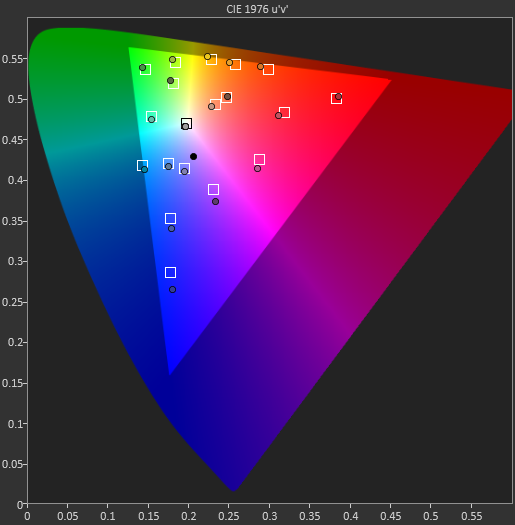
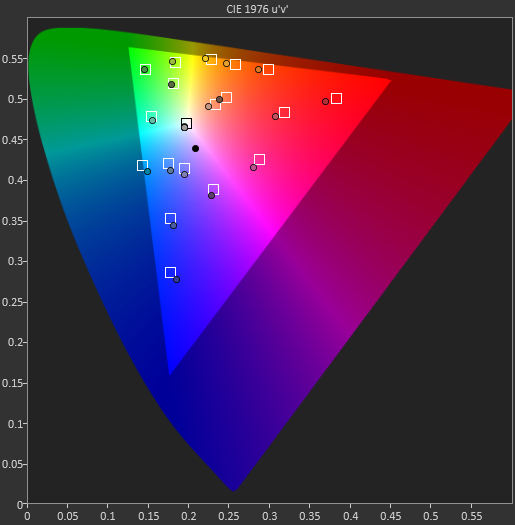








531 Comments
View All Comments
Der2 - Monday, November 2, 2015 - link
Its about time.zeeBomb - Monday, November 2, 2015 - link
Oh man...oh man it's finally here. I just wanted to say thank you for faithfuflly using all your findings to incorporate this review. It may have take a little longer than expected, but hey, this is my first anandtech review that I probably camped out for it to drop, lol...thanks again Joshua and Brandon!zeeBomb - Monday, November 2, 2015 - link
Ugh. I meant Ryan Smith...sorry! Waking up at 5 isn't the ideal way to go...Samus - Thursday, November 5, 2015 - link
That's what she said, Der bra.zeeBomb - Sunday, November 8, 2015 - link
Very valid point. Speaking of valid points... 500!trivor - Thursday, November 5, 2015 - link
Have to disagree with your statement that the high end Android phone space has stood still. With this round of phones the Android OEMs have all upped their game to approximate parity with the iPhones and in some cases exceed the performance and quality of images taken by an iPhone. In addition, on phones like the LG G4 the option of having manual control of your picture taking and supporting RAW/JPEG simultaneously is a huge advance for smartphones. Add to that, phase change focusing, laser rangefinder for close focus, generous internal storage (32 GB) and micro SD expansion (which works quite well on Lollipop - not sure about Marshmallow yet) you have a great camera phone. It also has OIS 2.0 (whatever that means) at a significantly lower cost than even the low end (16 GB) iPhone 6s @ $450-500 for the G4 versus $650 for the iPhone. While iOS seems to get apps updated a little quicker, look nicer from what I've heard and seem to be a little more feature rich. Conversely, the Material Design language has greatly improved the state of Android interfaces to give Android OEMs a much more stable OS - although the first builds of Lollipop were not ready for prime time. Also, let's not forget that Android dominates the low - middle range of Smartphones below $400 with near flagship specs, excellent cameras in phones like the Motorola Style (Pure Edition in the US), Motorola Play (is apparently the base model for the Droid Maxx 2 for Verizon, a number of the Asus Zenphones, the Moto G and E. Also, the new Nexus' (6P and 5X) are both competitive across the board with new cameras with 1.55 micron pixels that let in significantly more light than the 1.12 pixels in other cameras, are competitively priced (especially the 6P @ $499), and are overall very nice handsets. Finally, the customizability and wide variety of handsets at EVERY PRICE POINT make Android a compelling choice for many consumers.Fidelator - Friday, November 6, 2015 - link
I couldn't agree more, the Android space has not stayed still, if anything, most of the problems on that side were due to Qualcomm's lack of a good offering this year, still, the phones were further refines in other areas, saying this is overall the best camera phone given the only advantage it has over the competition is reduced motion blur is complete bull, the UI is far from the best given that auto on both the SGS6/Note 5 and the G4 is as effective yet those still offer great manual settings.The -barely over 720p- display on the 6S is inexcusable for 2015 and given the starting price of the 6S should not be passed as an acceptable not even as a good display.
Where Apple deserves credit is with the A9, it is miles ahead of anything the competition currently offers, they have made some fantastic design choices, it just is on the next level.
robertthekillertire - Monday, November 9, 2015 - link
I'm actually very happy with Apple's decision to stick with a lower-resolution screen. Which would you rather: a smartphone with an insanely high pixel count that your eyes probably can't appreciate anyway, or a smartphone with a lower PPI (but barely perceptibly so) that gets better battery life and has smoother UI and game performance because it's not trying to push an absurd number of pixels at any given moment? The tradeoff just doesn't seem worth it to me.MathieuLF - Tuesday, November 10, 2015 - link
But your eyes can tell the difference... When I had my iPhone 6+ and Nexus 6P side by side I can see it right away that the Nexus has more pixelsCantona7 - Tuesday, December 1, 2015 - link
But the difference is not large enough to justify heavier power consumption and greater graphics requirement. I agree that more pixels is certainly more pleasant to the eyes, but I'd rather greater battery life. If the Nexus 6P had a lower resolution screen, it would have a even greater battery life which would be awesome